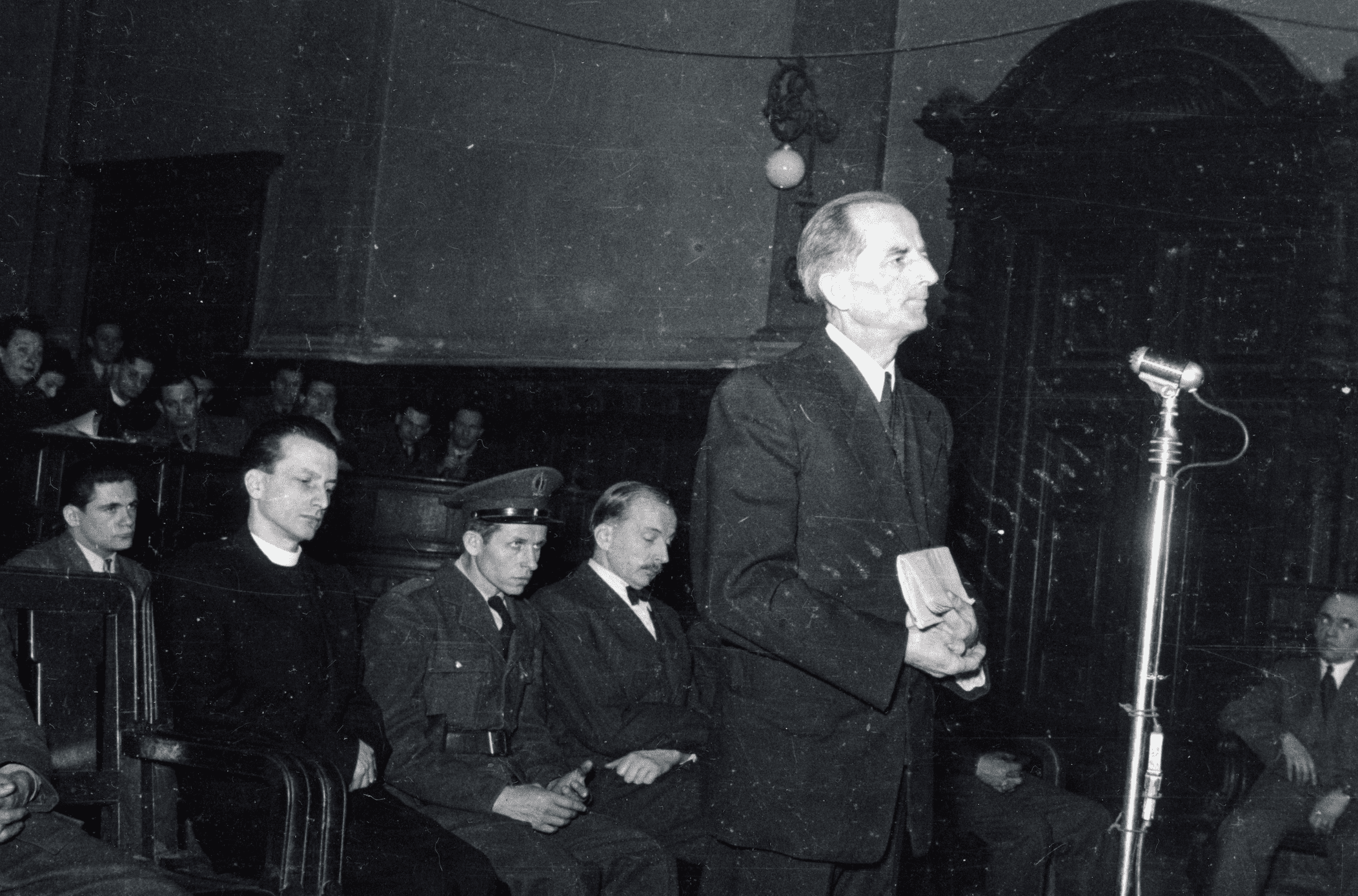In the city of Debrecen, the Provisional National Government was formed on 22 December 1944 to bring war criminals to justice and, if necessary, to extradite them to other countries. The declaration was defined in the ceasefire agreement signed with the Soviet Union on 20 January 1945. According to the preliminary segment of the completed decree, the goal was that ‘those who were the instigators of or contributors to the grand disaster affecting the Hungarian people should be reprimanded with the utmost speed’. These processes later became known as the People’s Tribunals.[1]
The finished regulation—amended many times later on—was issued by Prime Minister Miklós Béla Dálnoki on 25 January 1945 as Premier’s Decree [M.E.R.] Nr. 81/1945 and used very vague terms in defining war crimes and ‘crimes against the people’ – perhaps deliberately, so that later processes could be launched against virtually all enemies of the communist regime. This is not to say that real war criminals were never prosecuted and that there was no real need to bring Nazi war criminals to justice. But the subsequent show trials quickly showed that where the rights of one were breached, the rights of all people were in danger.
People could be reported to the police and the People’s Prosecutor’s Office
There were several ways to get into the system of People’s Tribunal (Népbíróság) proceedings. After the Second World War, certification committees were set up, which combed the population from institution to institution, from factory to factory, from occupational group to occupational group, all the way down to the municipal level. If someone was not verified, his case was handed over to the People’s Prosecutor’s Office (Népügyészség), which could decide to prosecute. In addition, as today, people could be reported to the police and the People’s Prosecutor’s Office. People’s Tribunals were able to prosecute at two levels: in the lower courts at the country centres or major towns and in the higher court before the National Council of People’s Tribunals (Népbíróságok Országos Tanácsa –NOT).
The councils of the People’s Court on the local level were chaired by a qualified judge, but he did not vote, only informed the other members of the council, who were delegated by the five left-wing parties of the Hungarian National Independence Front and the trade unions. People’s Tribunals handled war crimes and less serious “anti-people crimes”, but in some cases the Criminal Code may also have been applied. Penalties ranged from death to severe forced labour to imprisonment and minor fines. Until their liquidation in the spring of 1950, the people’s courts examined more than 59,000 cases in Hungary, of which approximately 27,000 convictions were handed down, and 189 of the 477 death sentences were carried out. Yet, the People’s Tribunals law was used against later enemies of the communist state too, such as the 1956 revolutionaries.

János Kádár, at the time deputy secretary of the Communist Party, reported anti-semitic murderers to the police, who were tried and executed
In fact, the very first People’s Tribunal showed the influence of politics in the reckoning: in January 1945, János Kádár, at the time deputy secretary of the Communist Party, reported anti-semitic murderers to the police, who were tried and executed. Yet, as historians have pointed out that at least one false testimony was used in the proceedings. According to the recollection of the Presiding Judge of the People’s Tribunal Ákos Major, their public execution was forced by influential communist politician Zoltán Vas.[2] The case raises an important question: should we believe the court documents of a case where the prosecuted people did not deny their crimes at all, but where falsified documents have also been used? Can a trial be labelled only “partially corrupt”? Doesn’t this destroys faith in the entire process and in the People’s Tribunal justice?
To answer the question, we must look at how people’s tribunals were seen in the communist-oriented public life. The People’s Tribunals were the ‘fist of democracy’ – asserted in a rural left-wing newspaper in 1947.[3] Here, the word ‘democracy’ means ‘the people’s democracy’, of course, that is, socialism. ‘The process of cleansing has begun across the country. We hope that the hurricane of justice will whirl through the dim clouds of justice.’ The article itself was, in fact, very critical of People’s Tribunals, claiming that the courts regularly let Nazi criminals go unpunished, and demanded that more guilty verdicts be handed down.
Judges who were too “soft” on criminals were regularly intimidated; lawyers who defended the accused were openly criticized, and numerous cases of manipulated trials, falsified testimonies and state controlled defamatory press campaigns are known. In future articles I will describe such cases to give a more balanced account of the People’s Tribunals in the years 1945–1949.
[1] On this see my unpublished manuscript regarding People’s Tribunals, prepared for the Nemzeti Emlékezet Bizottsága.
[2] László Varga, ‘Forradalmi törvényesség… Jogszolgáltatás 1945 után Magyarországon’, Beszélő, (11/1999), 64-73. See also: Géza Komoróczy, ‘A zsidók története Magyarországon‘,(Pozsony:Kalligram, 2/2012), 893–894.
[3] Néplap (Debrecen), 23 March 1947.







